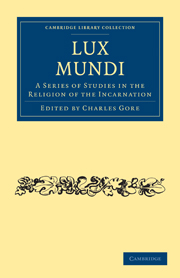Book contents
- Frontmatter
- ESSAYS AND CONTRIBUTORS
- PREFACE
- PREFACE TO THE FIFTH EDITION
- PREFACE TO THE TENTH EDITION
- Contents
- I FAITH
- II THE CHRISTIAN DOCTRINE OF GOD
- III THE PROBLEM OF PAIN
- IV PREPARATION IN HISTORY FOR CHRIST
- V THE INCARNATION AND DEVELOPMENT
- VI THE INCARNATION AS THE BASIS OF DOGMA
- VII THE ATONEMENT
- VIII THE HOLY SPIRIT AND INSPIRATION
- IX THE CHURCH
- X SACRAMENTS
- XI CHRISTIANITY AND POLITICS
- XII CHRISTIAN ETHICS
- APPENDIX I ON SOME ASPECTS OF CHRISTIAN DUTY
- APPENDIX II ON THE CHRISTIAN DOCTRINE OF SIN
APPENDIX II - ON THE CHRISTIAN DOCTRINE OF SIN
Published online by Cambridge University Press: 29 August 2010
- Frontmatter
- ESSAYS AND CONTRIBUTORS
- PREFACE
- PREFACE TO THE FIFTH EDITION
- PREFACE TO THE TENTH EDITION
- Contents
- I FAITH
- II THE CHRISTIAN DOCTRINE OF GOD
- III THE PROBLEM OF PAIN
- IV PREPARATION IN HISTORY FOR CHRIST
- V THE INCARNATION AND DEVELOPMENT
- VI THE INCARNATION AS THE BASIS OF DOGMA
- VII THE ATONEMENT
- VIII THE HOLY SPIRIT AND INSPIRATION
- IX THE CHURCH
- X SACRAMENTS
- XI CHRISTIANITY AND POLITICS
- XII CHRISTIAN ETHICS
- APPENDIX I ON SOME ASPECTS OF CHRISTIAN DUTY
- APPENDIX II ON THE CHRISTIAN DOCTRINE OF SIN
Summary
‘Jesus did not commit Himself unto them, because He knew all men, and needed not that any should testify of man: for He knew what was in man.’
—S. John ii. 24, 25.‘Sin is lawlessness.’
—1 S. John iii. 4. [R.V.]‘He knew what was in man.’ The words describe our Lord in presence of a fact universally recognized—man's moral unsatisfactoriness. He looks steadily at man's first offer of service, at man's first enthusiasm, when ‘many believed in His name,’ and He discerns behind it a disqualifying cause; something which prevents Him from trusting man as he is, and from committing to him the great work of His kingdom. He sees sin in man and all that sin involves of moral failure, of refusal to endure, of spiritual blindness, of lawless self-assertion, of passion, of selfishness, of self-will. That there is in human nature this disqualifying taint of sin is, we may say, a fact universally recognized. It is the fact which in slow embittering experience has turned philanthropists into cynics and saddened the wisest. But to our Lord it was a fact present from the first. ‘He needed not that any should testify of man.’ He reckoned with sin to start with. Therefore He could not use mankind, as it offered itself, for His purposes. It needed a fresh start, a vital re-creation, to fit it for such high ends.
- Type
- Chapter
- Information
- Lux MundiA Series of Studies in the Religion of the Incarnation, pp. 387 - 395Publisher: Cambridge University PressPrint publication year: 2009First published in: 1889



